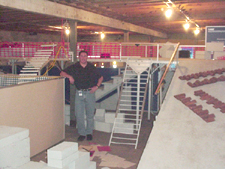Page 2
The
course measures 20 meters (60
feet) on a side, the square test course is composed of three successively
more difficult modules.

Dr. Adam Jacoff stands in the NIST/DARPA Autonomous Mobile Robot Evaluation Course.
The NIST work is jointly sponsored with the Defense Advanced Research Projects Agency (DARPA). In each module, a variety of overt and hidden “targets” are placed for robots to locate and identify. These include mannequins, infrared emitters (tuned to the temperature of the human body), clothing, moving body parts, hoses that emitted compressed air (to represent gas leaks) and recorded sounds of human voices. A CD-ROM, including Light Detection and Ranging (LIDAR) data, contains important information from
Reference Test
Arenas for Autonomous Mobile
Robots. The data is important
to researchers in refining their computer programs and standardizing the
output. It may be downloaded
from the web site: http://www.isd.mel.nist.gov/
Of interest to the fire service is a new competition sponsored by AAAI. It is the Rescue Robot Competition. Robots must enter a fallen structure, locate human victims, and direct human rescuers to the victims.
For more information go to their web site:
http://robomec.cs.kobe-u.ac.jp/
Fire departments who are interested in partnering with Adam Jacoff in developmental work or who would like to have their robots and robotic operators use the NIST test facility should contact him directly. Adam may be reached at (1) + 301-975-4235, or adam.jacoff@nist.gov.
The worst Tokyo building fire
in recent memory took the lives of 44 people and injured three others on
September 1, 2001. It is
thought that the fire started before 1:00 AM in a third floor staircase in
Myoio 56, Shinjuku, which housed five entertainment facilities.
The total building area was 498 m2 from the 2nd
basement floor to the 4th floor.

The
fire started in the only staircase and is believed to be the primary reason
for the high number of deaths. The
sole evacuation route was filled with smoke and dust; it also was reported that
there were a large number of combustibles placed in the staircase at the time
of the fire. Therefore, it was
difficult for the building occupants to evacuate and for firefighters to gain
access to the fire via the stairs. Experience
indicates that fires in staircases of small buildings are most likely the work of
arsonists.
Although fire doors were installed in the 3rd and 4th floors between the staircase and private use area for tenants, they were not closed during the fire. This may have been because: the smoke detector was disconnected or malfunctioning, and/or objects were placed in front of the fire doors.
Another
possibility is that incomplete combustion caused a large amount of carbon
monoxide to be generated because fuel was burnt in such a small, confined
area as a staircase.
The
National Research Institute of Fire and Disaster (NRIFD) in Tokyo, Japan,
had the responsibility of performing a series of fire experiments.
A 4-story mockup of a staircase was used to:
investigate
the fire behavior and/or combustion of fire source according to different
opening conditions, size and kind of fire source, and position of fire
sources;
observe
to what extent carbon monoxide is generated;
investigate what is the most appropriate position for smoke detectors and sprinkler heads in a staircase, if the equipment were to be installed there.
A
short report of this study will be presented at the May 2002 Annual Meeting
of the Japan Association of Fire Science and Engineering in Tokyo.
For further information contact: Dr. Ai Sekizawa, Tel: (81) + 422-44-8439; fax: (81) + 422-42-7719, e-mail: sekizawa@fri.go.jp.

A flame extended from the third floor level was ejected from the open door on the 4th floor.